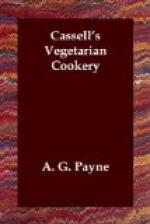N.B.—A few red currants should be mixed with the raspberries. Should the colour be poor, brighten it up before freezing with a little cochineal.
ICES FROM JAM.—Mix a quarter of a pound of any jam with half a pint of the mixture made for ice cream (see ICE CREAM, CHEAP), without any flavouring such as vanilla. Rub all through a fine sieve, and freeze. Cochineal will give additional colour to red jams; spinach extract to green jams; and a very little turmeric, or yellow vegetable colouring, to yellow jams. A small pinch of turmeric can be boiled in the milk.
ICE, LEMON-WATER.—Rub six lumps of sugar on the rind of six lemons, add this and the juice of six lemons to a pint of fairly sweet syrup. The amount of sugar is a matter of taste. Strain and freeze. Some persons add a few drops of dilute sulphuric acid.
ICE, ORANGE-WATER.—Act exactly as in lemon-water, using oranges instead of lemons, and syrup containing less sugar.
ICE, WATER FRUIT.—All sorts of water fruit ices can be made by mixing half a pint of juice, such as currant-juice, with twice that quantity of syrup, and freezing. Grated ripe pine-apple, pounded and bruised, ripe cherries and greengages, strawberry-juice, raspberry-juice, can be mixed with syrup and frozen. Sometimes a little lemon-juice can be added with advantage, and in the case of cherry ice and greengage ice a little noyeau added is an improvement.
CHAPTER XIII.
CAKES AND BREAD.
In vegetarian cookery there is no difference, as far as cake-making is concerned, between it and ordinary cookery. In making cakes we will confine our attention chiefly to general principles which, if once known, render cake-making of every description comparatively easy work. Those who wish for detailed recipes for making almost every kind of cake known will find all that they require on a large scale in “Cassell’s Dictionary of Cookery,” and also everything necessary on a smaller scale in “Cassell’s Shilling Cookery,” which has already reached its hundred-thousandth edition.
Cakes may be divided into two classes—those that contain fruit and those that do not. Plum cakes can be made very rich indeed, like a wedding cake, or so plain that it can scarcely be distinguished from a loaf of bread with a few currants in it. Again, cakes that contain no fruit can, at the same time, be made exceedingly rich, the richness chiefly depending upon the amount of butter and eggs that are used. We will first give a few directions with regard to making what may be termed plain cakes, i.e., cakes that contain no fruit at all. Perhaps the best model we can give to illustrate the general principles will be that of a pound cake. The recipe is a very easy one to recollect, as a pound cake means one that is made from a pound of butter, a pound of sugar, a pound of eggs, and a pound of flour. There is one addition, however, which the good plain cook will probably not be up to, and which, so far as flavour is concerned, makes all the difference between Francatelli and “Jemima Ann”—we must rub some of the lumps of sugar on the outsides of either two oranges or two lemons. It is also a great improvement to add a small glass of brandy, and in every kind of cake we must add a pinch of salt.




